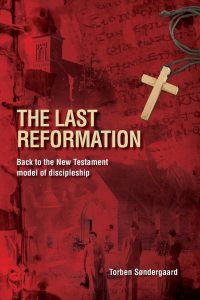Review: The Last Reformation – Back to the New Testament Model of Discipleship
 What’s gone wrong with the church? Surely, new life in Jesus and the Kingdom of God are so much more than stultified, sanitised, professionalised institutions? How do we organise ourselves so that there is more freedom for the Holy Spirit? How can we be the true embodiment of the world-changing gospel like we see in the early church of Acts?
What’s gone wrong with the church? Surely, new life in Jesus and the Kingdom of God are so much more than stultified, sanitised, professionalised institutions? How do we organise ourselves so that there is more freedom for the Holy Spirit? How can we be the true embodiment of the world-changing gospel like we see in the early church of Acts?
That’s what this book is about. Torben Sondergaard, a Danish evangelist with a growing influence and impact penned this book some years ago. Amongst other things, it is required reading for those wanting to be trained under the imprimatur of his movement.
I have just finished reading it and I am left uneasy. This is a divisive book, for which Sondergaard is unapologetic (“We are going to be accused of destroying the church.”, p13). He interacts with some important issues. He taps into a disillusion amongst some of Jesus’ people: “There are many who are dissatisfied and frustrated because they are not being used and are not growing in the things that God has put in them” (page 96). His response, I think, is sincere. In the end, however, it is flawed.
I’ve had to check myself continually. Perhaps my unease is appropriate; as a vicar I represent the sort of churchiness that Sondergaard is rightly critiquing. Maybe I’m biased as Sondergaard attempts to deconstruct my current way of life. After all, I’m a professional churchman; the church institutions house and feed my family. My expertise, my career, my “marketable skills”, let alone my sense of vocation and divine purpose are woven into a form of church from which Sondergaard is pulling loose threads. So I’ve had to question myself: is my unease with this book just a form of self-preservation? I don’t think I’ve fallen into that trap.
After all, there’s a lot that I like. As he assesses the problems we face, I am often nodding my head. I love the church. It can and is a location of great blessing. Nevertheless…
1- Church culture often obscures Jesus rather than revealing him. Sondergaard writes, “We do not need to impose our church culture on people in order to make them ‘proper Christians.’ Rather, when we remove today’s church culture, we will see that people are more open to God” (page 21). I, personally, know what it’s like to find myself steering someone who is new to the faith away from the church world, and towards contexts where there is a deeper sense of spiritual family and where Jesus is acknowledged and relied upon. The way we do church doesn’t always have the presence of Jesus as a factor; it can be a toxic and neglectful environment.
2- Our churches appear spiritually stagnant and ill-prepared. “I look at churches in the West, I can see that they need to be refreshed” (page 23). I have felt this as a pervasive sense of dissatisfaction in the status quo. Even when we are blessed and fruitful, we cannot simply stop as if we’ve “made it” and be satisfied with the way things are. “Semper reformanda,” our forefathers said; the church needs continual reformation. We are not pursuing Jesus enough. We are not prepared for difficulty and adversity, let alone persecution, should it come. “The big churches will suddenly become small when they find out that following Jesus has a high price, a price most of them have never been willing to pay” (page 25).
3- Hierarchy (both formal and informal) beats discipleship in many churches. When I hear stories of people being raised up, nurtured, covered, cared for, and released, they often attend to people and relationships that are usually (but not always) outside of church structures. Here there is true accountability, an honesty and freedom to share difficulties, and receive help. However, within the structures, the stories are often different; they tell the tale of arbitrary hoops to jump, faceless people making decisions for you and not with you, power plays and spin. This is where accountability is reduced to box-ticking and number crunching; no-one “has your back” and, rather than freedom to grow, there is a subtle (and sometimes not so subtle) demand for complicity and conformity. When Sondergaard speaks of how “mature Christians get locked up in a hierarchical system that stops them from making progress” (page 43) he touches on these things. I don’t fully agree with how he deals with this phenomenon, but it’s right to raise the issue.
4- Church culture often has a worship problem. The so-called “sacred-secular divide” is much deeper than the “Monday-Sunday” separation that is usually used to describe it. Rather, it’s a cultural demarcation that defines claims on our time, money, and life. It’s as if we say, “Sunday mornings and 10% of my income, and some other contribution belongs to God and the church and the rest is mine.” Churches buy into this culture in order to facilitate collective goals and providing a means for people to contribute their bit. This isn’t a bad thing, but it can be self-defeating. Regarding tithing: “all our money belongs to God and not just ten percent… tithing can actually keep people in their comfort zones” (page 61). Indeed, true worship is about being a “living sacrifice”, a hundred holistic percent. It’s about giving Jesus all of our lives – our money, our time, our family, our identity, our career. This is how we worship (Romans 12:1), but we rarely nurture it in our church contexts.
5- Church culture often has a flawed sense of growth. I trained during the latter part of the Hybels-esque “church growth” era, shaped by being “seeker sensitive” and offering “homegenous unit” activities for the different blocs of children, youth, men, women, marrieds, singles etc. Growth was about presenting a pleasant and non-threatening atmosphere and getting people in the door and onto the seats. Some good things have come from this mindset, but in general it is a failed experiment that breeds passive consumer Christians. I’m not sure it’s necessarily true that “pastors and leaders… are mostly focused on how to get non-Christians to come to their church” (page 65) but I agree that “they should be looking to God to find the best way to equip the Christians who are already there” (pages 65-66).
I even resonate with some of Sondergaard’s experiences. Gill and I have been pioneers and church planters, and we have seen, time and time again, how something exciting and new can easily fall back into the rut grooved out by expectation and weariness. “This is not different at all! This is exactly how we held meetings in the other church.” (page 37).
Moreover, Sondergaard has given me some helpful food for thought. His treatment of fivefold ministry is generally very good (and even lands the apostolic in the right place at 1 Corinthians 4 – page 120). His emphasis that the fivefold gifts are most effectively expressed as itinerant ministers equipping local churches is intriguing, and I’ll give it further thought.
Yet despite all this, I am still uneasy about this book. His solution to these problems is flawed.
Sondergaard’s solution is his titular “last reformation”. He sees the need for a dramatic shift of the size and significance of Luther and Wesley, that would, unlike them, “transform our whole church structure” (page 12, emphasis mine). This imagined realignment of structure is shaped around his understanding of the early church in Acts: smaller household-sized communities, with a flatter organic leadership structure, that fosters spiritual activism (including the supernatural ministries of healing the sick and casting out demons), and which avoids the hierarchy, inertia, and control of larger organisations.
It’s a worthy vision. Structurally, it seems very similar to the house-church movement of the ’70s and the broader cell-church movement in general. It resonates with the “missional discipleship” movement of the ’00s, and the emphasis on “oikos”/household sized “missional communities.” In terms of missional ethos, it is similar to contemporary embedded communities such as Eden and parachurch organisations such as YWAM bases.
So again, why am I uneasy? I’ve distilled it down to three concerns:
1- His vision is self-defeating. There’s more than a hint of pathos at times (“I felt we could not put up with the rejection any longer.” page 41). Believe me, I get it. But a firmer foundation is needed. Here’s my concern:
The early church model in Acts is intriguing and attractive. However it was far from perfect, even in those early primal years. Read the first few chapters of Revelation and you’ll see how spiritually ineffective they could be! Moreover, the evolution of the early church, even before Constantine, was not due to a hardening of heart away from the will of God. It was moved by a desire to remain true to Jesus (apostolic succession, canon of Scripture), to flourish in faith amidst persecution (liturgical rhythms, appointment of pastors and leaders etc.), and to combat heresy and defend belief (trinitarian theology, apologias). Inevitably these lifegiving currents were, naturally, systematised. The assumption that the early church was great and it became increasingly bad does not entirely match reality. Sondergaard doesn’t seem to grasp this. e.g. He makes the curious observation that in the early Church “No one but Jesus was the Head of the fellowship, and it was clear to everyone” (p135), and doesn’t recognise that the Holy Spirit manifested that leadership through Councils of elders (Acts 15) and the sending of corrective letters from people in authority (Paul’s epistles)!
Even if Sondergaard were able to re-manifest that early church purity (on his terms of purer structures), it would inevitably (on those same terms) apostasize, just like the early church. You see, it’s already happening. Sondergaard is growing a movement. He has written a definitive book that is essential reading. He is playing the part of apostolic overseer and doctor-theologian. Within this movement, he defines what is orthodox, and what is not. As the movement grows, it will require infrastructure to organise and (ta da!) hierarchy to ensure that the core values of the movement are held and acted upon. None of that is bad! As long as you realise that this is what is happening and play your part well. I’m not sure he sees it.
What I think I see here is something I’ve observed in other contexts – a form of ecclesiastical nihilism. “I’m not your pastor”, someone says by way of pastoral advice. “I’m not the leader”, they say, leading the way. “We trust in the Holy Spirit alone,” they say, by way of articulating the Holy Spirit’s guidance. “We are not full of ourselves”, they say, by way of self-description. The only way forward is to not pretend: you are a pastor, a leader, a discerner of God’s will. You do help shape our identity and place; now do it well!
Similarly, to Sondergaard, who imagines when people “once again begin to meet in homes and on the streets where there are no big names, programs, or oganizations” (page 83) while writing a book with his name on it, offering pioneering training programs, and fronting an organisation: Don’t pretend you have discovered a pure form of doing church (which would necessarily need to be purer than the early church that, eventually, ended up with us!). Don’t pretend you have somehow avoided the pitfalls of structure and hierarchy and the pressures of collective identity; admit that you’ve actually got those things… and do them well. Stand on the shoulders of those who have literally done before what you are doing now. A little humility would not go amiss.
Relatedly,
2- He’s honed in on the wrong problem. The problem is culture not structure. His critique of church culture is worth hearing. But his structural proposals are not novel, nor are they essential to the changes we need.
Sondergaard often plays existing church systems as a straw man. For instance, he rightly envisions a situation when smaller communities of faith can reproduce themselves quickly and efficiently. But he asks things like this: “Why are the churches so afraid of new fellowships if all the numbers show that this is the solution to reaching the world?” (page 45) They’re not! They might not be very good at it. And the big monolithic techniques of resource church mega-plants may not be my cup of tea… but everyone recognises that “church planting” or “fresh expressions of church” (when defined well) are essential to the way forward. And some even manage to do it.
Similarly, “Imagine that a matured married couple… come to the pastor and say: ‘We’ve really been seeking God, and we feel that it’s time for us to move on… We would like to have your blessing.’ Do you think the pastor will bless them?” (page 54). Well, yes! Sondergaard implies that the pastor would withhold the blessing in order to manipulate continued membership and financial support. Really? If that happened, that wouldn’t be a structural problem, but a competence problem! And if it was pervasive, it would be a cultural one.
In every structure, I can find (or at least imagine) a church culture which alleviates all the concerns such as spiritual stagnation and lack of discipleship. I even see existing churches doing things that Sondergaard aspires to. e.g. I know of a church who is more than “happy to see people start their own [church] families in the neighbourhood instead of waging war with them.” (Page 51, NB. it’s either “happy to see” or “waging war” – there’s the straw-man false dichotomy again). Similarly, in every structure I can find – including house church movements like Sondergaard – I can find spiritual lethargy and even toxicity.
We don’t need to reform the skeleton of the church – it’s structures – we need to reform the heart of the church. We need to fall in love with Jesus again, and to embrace that love and devotion individually, collectively, corporately. I have encountered that heart in the smallest of home churches, and in the biggest of cathedrals; in the most organic of prophetic communities, and in the most structured of liturgical settings. It’s not the structure that matters, it’s whether or not those in the structures devote them to Jesus or not. Sondergaard briefly touches on this peripherally (“many… issues would be resolved automatically if people would simply repent and get saved”, page 134), but it is the heart of the matter.
3- His vision is too small. Reformations of the church have both discontinuity (a big shift from what was before) and continuity (it is still rooted in the ancient works of God). Sondergaard emphasises a discontinuity and achieves it because he takes a narrow field of view. His awareness of the nature and character of the Body of Christ doesn’t see the beauty and depths of existing traditions.
I can see how Sondergaard’s vision would rest well within some of the charismatic and pentecostal traditions. But even I struggle with his over-realised eschatology. I am no cessationist. I’ve got a lot a time for “Naturally Supernatural” activities, when done sensitively and well, such as Healing On The Streets and Healing Rooms etc. But you don’t have to look too much at Christian history to recognise that those who say “Jesus is coming back very soon, and I am convinced that we are the ones who will see His return” (page 15, emphasis mine) should be heard with a raised eyebrow.
Similarly, he is has a closed hand on some issues that should be held more loosely. For instance, he anathematises infant baptism (p15). This is fair enough, I guess (I am open-handed on this issue!). But to assert that it is important to some churches merely because it “brings in money” (p57) is not only insulting, but blatantly untrue. I doubt any church I have been a part of has even broken even on providing the ministry of Baptism, let alone made a profit.
All this does is narrow the vision. Is there a place in this last reformation for my reformed brother and sisters, who emphasise the study of Scripture, and value the expertise of learned teaching? Is there a place in this last reformation for my contemplative and traditional brothers and sisters, who value how the Spirit has actually been at work in the church over the last millenia or two, and who draw upon those good, ancient forms? I can’t really see it.
In conclusion, this is a difficult book to read. For those who are in some sort of denial about the state of the church, it would be usefully provocative. But my unease at his “solution” remains.
Sondergaard says he is “not out to criticize pastors but to see them as victims of this system. I feel sorry for them, and I want to save them from it. The problem is not them, or any other people! No, it’s the whole church system we have built up.” (page 55, emphasis mine). I appreciate much of this sentiment. I have been a victim of the system, and, I suspect, a perpetrator of it as well. I love the church, in, around, and beyond the institutions of which I am a part. Which is why, occasionally, I look at it and despair. But I only need one Saviour, and he is the church’s Saviour as well.




